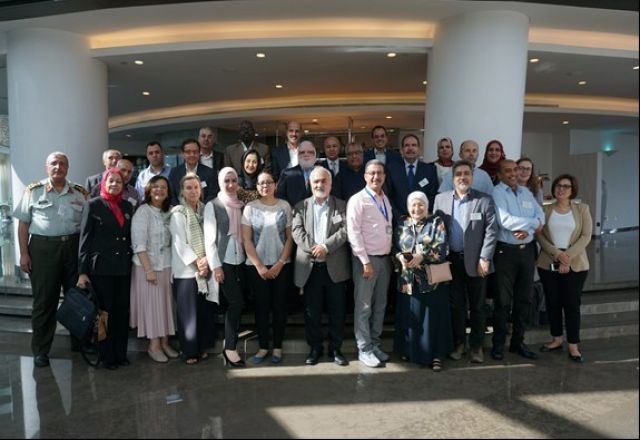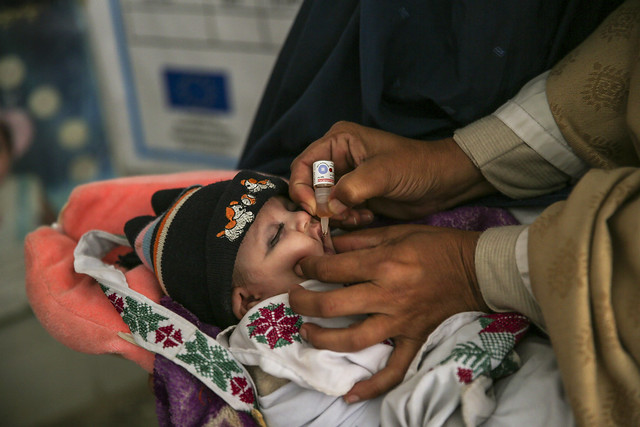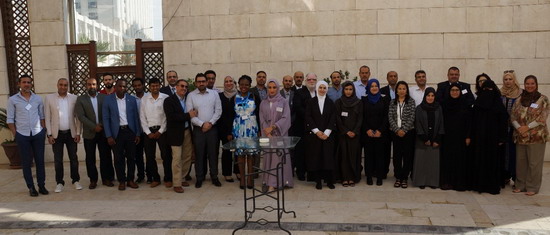Considering Primary Immune Deficiency in the Eastern Mediterranean Region
 Attendants of the Regional Meeting on Poliovirus Surveillance among Primary Immunodeficiency Patients in the Eastern Mediterranean Region, 28 – 30 October 2019, Amman, Jordan. ©WHO/EMRO
Attendants of the Regional Meeting on Poliovirus Surveillance among Primary Immunodeficiency Patients in the Eastern Mediterranean Region, 28 – 30 October 2019, Amman, Jordan. ©WHO/EMRO
20 February 2020 – In line with the Strategic Advisory Group of Experts (SAGE) recommendation and the Global Strategic Surveillance Action Plan 2018-2020, WHO EMRO and GPEI partners conducted the Regional Meeting on Poliovirus Surveillance among Primary Immunodeficiency Patients (PIDs) between 28-30 October 2019 in Amman, Jordan.
The meeting aimed to develop national plans for PID surveillance and identify next steps to roll out PID surveillance in selected countries. The lessons learnt from phase I implementation of the project will be used to implement PID surveillance elsewhere.
Dr Hamid Jafari, Director for Polio Eradication at WHO/EMRO, joined the opening session, and welcomed delegates from the four countries attending the meeting: the Arab Republic of Egypt, the Islamic Republic of Iran, the Republic of Tunisia, and the Hashemite Kingdom of Jordan. He also welcomed facilitators from WHO/HQ and partners from the US Centers for Disease Control and Prevention (CDC) and the Bill & Melinda Gates Foundation (BMGF), expressing his appreciation towards their efforts in polio eradication.
The countries were selected based on a Global Risk Assessment considering several risk factors for PIDs including: Consanguinity, occurrence of immuno-deficiency associated vaccine-derived poliovirus (iVDPV), oral polio vaccine (OPV) immunization rates, PID survival rate, previous experience with and inclusion in study projects, and experience with antiviral drug use.
PIDs are a group of up to 350 known diseases, which are caused by genetic defects of the immune system. A few types of PIDs are known to be associated with risk of prolonged excretion of viruses and subsequently their spread. This is a real threat for the polio programme after eradication, as children will become more vulnerable to infection with polio as immunity levels wane after cessation of polio vaccination. If polio is no longer present in the wild, this is not a problem, but if virus is unintentionally reintroduced to the environment by a PID patient, cases of paralysis could occur once again.
Dr Jafari noted that the significance of immune deficiency-related vaccine-derived polioviruses (iVDPV) has been recognized for several years. Treating those with PIDs is an important component of the 2019 – 2023 Endgame Strategy for the Global Polio Eradication Initiative.
Discussion at the meeting focused on reviewing the current situation of survey-based PID surveillance in the region. Countries presented their experience of antiviral introduction policies, mapped ways to ensure sensitive high-quality surveillance systems, and identified the next steps for effective operationalization of PID surveillance. The intention was to propose a public health response that reduces both individual risk of developing poliomyelitis and the risk to the community of poliovirus transmission. The Regional Office demonstrated a developed information system to support implementation of PID surveillance in the four countries at the meeting.
Key actions were agreed by countries, the WHO regional office, and the Global Working Group to complete over the coming months.
This is just the beginning of a long-term project to consider the needs of PID patients and their communities. By building strong relationships between different involved parties, progress can be made to detect and protect PID patients now and ensure that sturdy foundations are laid for supporting patients after the certification of polio eradication.
For more information on the discussions and outcomes of the meeting, please contact Dr. Muhammad Obaid-ul Islam Butt, Medical Officer for Surveillance, at buttmu[AT]who[DOT]int, or Dr. Ashraf Wahdan, Medical Officer for Certification and PID focal point, at wahdana[AT]who[DOT]int.
Mitigating the threat of poliovirus importation to Sudan
 A mobile vaccination team provides polio vaccinations to nomadic communities during the accelerated immunization campaign in October 2019 in Rehaid locality, on the border of Sudan and CAR. ©WHO/Sudan
A mobile vaccination team provides polio vaccinations to nomadic communities during the accelerated immunization campaign in October 2019 in Rehaid locality, on the border of Sudan and CAR. ©WHO/Sudan
12 December 2019 -- The World Health Organization and national health authorities in Sudan are scaling up efforts to reduce the risk of poliovirus transmission to the country. Sudan borders a number of countries facing outbreaks of circulating vaccine-derived poliovirus (cVDPV), including Chad and the Central African Republic (CAR) to the west, and Ethiopia and Somalia to the east. Population movements between these countries increase the risk of importation of polio to Sudan.
To prevent a possible outbreak, WHO and national health authorities have been working amidst immense operational challenges to implement vaccination campaigns and bolster disease surveillance. Public health teams in Sudan and CAR are collaborating to share details of vaccinated refugee children with their country of origin, and exchange information on upcoming supplementary immunization activities and reported cases of Acute Flaccid Paralysis.
In September and October 2019, states on the border between Sudan and CAR implemented accelerated routine immunization to provide children with coverage against a variety of vaccine-preventable diseases. Teams conducted reviews of vaccination facilities and posts in border areas, and orientation sessions were held in healthcare settings to reinforce reporting cases of Acute Flaccid Paralysis. Children received oral polio vaccine, pentavalent vaccine, and inactivated polio vaccine. Initial data from the campaigns suggest a spike in coverage, with teams reaching many children previously unprotected.
Sudan was declared free of wild poliovirus in 2015, but remains at considerable risk for poliovirus importation or a VDPV outbreak. Much of the risk is shaped by Sudan’s unique population dynamics, and by the effect of population movement, conflict and instability affecting routine immunization.
Over 8 million children under the age of five are estimated to live in Sudan – an age group considered to be most vulnerable to contracting and being paralyzed by poliovirus. Sudan also has large numbers of internally displaced people and refugees, many in areas of the country with the lowest levels of routine immunization, such as the Darfur region.
For further information about polio eradication in the Eastern Mediterranean and African Regions, and around the world, visit the Global Polio Eradication Initiative website, polioeradication.org/.
Tracking the poliovirus in the Eastern Mediterranean Region
 Majra Bibi gives polio drops to 10-day-old Bilal Khan at a health unit in Khyber Pakhtunkhwa province, Pakistan. The polio programme works to vaccinate every child and detect the poliovirus wherever it remains. ©WHO/Asad Zaidi
Majra Bibi gives polio drops to 10-day-old Bilal Khan at a health unit in Khyber Pakhtunkhwa province, Pakistan. The polio programme works to vaccinate every child and detect the poliovirus wherever it remains. ©WHO/Asad Zaidi
12 November 2019 -- In a rapidly expanding megacity, amongst conflict or in mountainous border areas, how does the polio programme deduce where the virus is hiding?
To eradicate the poliovirus, every child must be vaccinated. We must also detect where virus remains. The two key methods used to do this are acute flaccid paralysis (AFP) surveillance, which alerts the programme to children exhibiting the key sign and symptom of polio, and environmental surveillance, which is used to detect the poliovirus in the sewage water systems of communities. But the most skilled disease surveillance officers can go one step further.
By cross referencing AFP and environmental surveillance data with data on immunization activities, population movements and high-risk populations, surveillance officers can learn to interpret the poliovirus risk in the countries where they work. Through painstakingly piecing these clues together, they can determine where there may be a high chance of polio re-appearing.
Disease surveillance officers and data managers from across the Eastern Mediterranean Region came together across a series of workshops held in September and October 2019, to learn how to use QGIS mapping software to record the clues that help the polio programme determine where the virus could circulate. Representatives attended from many member states in the region, three levels of the World Health Organization (WHO), and from CDC STOP, the Eastern Mediterranean Public Health Network, the VPI WHO EMR team, and the UNICEF MENA Regional Office.
 GIS and Mapping expert Ravi Santhana Gopala Krishnan presents aspects of QGIS to meeting participants. ©WHO/EMRO
GIS and Mapping expert Ravi Santhana Gopala Krishnan presents aspects of QGIS to meeting participants. ©WHO/EMRO
QGIS is a powerful open-source Geographic Information System that supports editing, storing, analysing and displaying diverse geospatial data. The workshop taught the officers to use QGIS and mapping services in addition to other risk assessment tools to provide decision makers with a clear picture of country surveillance indicators, AFP cases, the geographical reach of routine and supplementary immunization activities, and data on accessibility and the movement of high-risk populations.
Information can be layered in QGIS to create a highly detailed virtual map with key indicators and risks for disease spread. For instance, it would allow programme officers to spot a high-risk area where there is a low level of AFP reporting, where there is high population movement, and where few vaccination campaigns have been carried out and children have low immunity to the virus.
In other words, the maps allow real time analysis of outbreak risk. This information can then be used to strategize upcoming supplementary immunization campaigns and technical surge support or make recommendations to improve programme performance.
QGIS is free, works on mobile phones, and does not require a license, making it ideal for use in resource-poor contexts where the expensive licenses required for other GIS applications are not a viable option for some users.
The workshop ultimately aimed to empower surveillance officers and data managers to create maps that will help them to spot areas of concern and develop mitigation strategies. They learnt how to overcome common challenges, for instance, how to reconcile data sets created in different programmes, and how to treat data that arrives without a dedicated GPS coordinate.
This training is just one strategy to improve our ability to prevent outbreaks and stay ahead of the virus, in some of the most challenging epidemiological contexts in the world.
 Participants at the first QGIS training, held in September 2019. ©WHO/EMRO
Participants at the first QGIS training, held in September 2019. ©WHO/EMRO
 Participants at the second QGIS training, held in October 2019. ©WHO/EMRO
Participants at the second QGIS training, held in October 2019. ©WHO/EMRO
Related link
Out-running polio: an ultra-marathon runner’s dedication
Ala Baydoun dedicates her ultra-marathon run in Jordan to raise awareness in the final fight against polio
 Ala Baydoun runs through the Jordanian desert in the Rum International Marathon. Ala dedicated her run to raise awareness for polio eradication. Photo: Ali Barqawi22 January 2018 – It’s just after 6am on a Friday morning in Petra, one of Jordan’s ancient southern cities. Ala Baydoun ties her shoe laces with an extra secure knot as she prepares for what is no normal run. It’s the first day of her weekend and Ala will run for 100km to Wadi Rum in an Ultra Marathon, an effort that she’s dedicated to polio eradication.
Ala Baydoun runs through the Jordanian desert in the Rum International Marathon. Ala dedicated her run to raise awareness for polio eradication. Photo: Ali Barqawi22 January 2018 – It’s just after 6am on a Friday morning in Petra, one of Jordan’s ancient southern cities. Ala Baydoun ties her shoe laces with an extra secure knot as she prepares for what is no normal run. It’s the first day of her weekend and Ala will run for 100km to Wadi Rum in an Ultra Marathon, an effort that she’s dedicated to polio eradication.
Taking her position at the starting line, she looks calm and collected, despite the high altitude and the 8 km of hilly terrain immediately ahead of her.
After a grueling 14-hour run, through the desert, Ala crosses the finish line in second place and cuts more than 2 hours off her personal best time.
“I was injured and wasn’t sure I would finish the race, but I beat my time from last race! As runners we are so cautious of seconds, so to say that I cut 2 hours off is a big deal.”
Ala works for the World Health Organization and says that dedicating the run to ‘end polio’ was important to her.
 Ala hits the pavement every day running anywhere between 10 and 15 kilometres in Amman, Jordan. On a Friday she’ll run between 30 and 35 km. She dedicated her run in the Rum International Marathon to ending polio. Photo: Ali Barqawi“We haven’t seen polio in Jordan now for many years, but it remains a risk because it continues to circulate in countries in the Region. I work with a team of people who are very dedicated to finally ending polio around the world, and I know we are so close. This was a way that I could continue to raise awareness around this cause,” she says.
Ala hits the pavement every day running anywhere between 10 and 15 kilometres in Amman, Jordan. On a Friday she’ll run between 30 and 35 km. She dedicated her run in the Rum International Marathon to ending polio. Photo: Ali Barqawi“We haven’t seen polio in Jordan now for many years, but it remains a risk because it continues to circulate in countries in the Region. I work with a team of people who are very dedicated to finally ending polio around the world, and I know we are so close. This was a way that I could continue to raise awareness around this cause,” she says.
A born runner, Ala hits the pavement every day running anywhere between 10 and 15 kilometres in Amman. On a Friday she’ll run between 30 and 35 km outside the city, which she says is partly out of love and partly to train.
“I’m a road runner by obligation because it’s too far to travel to run regularly in the desert, and completing trail runs in Jordan can be dangerous for a woman running solo. Basically I’d need a group of men running with me and that’s not always possible, nor is it practical.”
This isn’t Ala’s first ultra-marathon and certainly not her first time running through the desert. She’s competed in a number of races and running events in Jordan and overseas, inspired often by her marathon-running father. “Running is in my blood,” she says.
“I remember the first time I started running, when I was about 12 years old and I couldn’t complete 3 kilometres with him. But then we started going out every day, and quickly I got faster and realized how much I loved it.”
Now, she says, that love of running is what keeps her motivated on the big runs.
 Ala says the runners high, when the endorphins kick in’ is what keeps her motivated to keep running during big running events. She placed second in the Rum International Marathon. Photo. Ali Barqawi“You have to motivate yourself, because you’re in the middle of nowhere, often alone. One negative thought in that environment can really derail you. And you’re not only thinking about keeping motivated and positive, you’ve also got other things to be thinking about…like there are stray dogs in the desert and running in the sand requires so much more effort,” she says.
Ala says the runners high, when the endorphins kick in’ is what keeps her motivated to keep running during big running events. She placed second in the Rum International Marathon. Photo. Ali Barqawi“You have to motivate yourself, because you’re in the middle of nowhere, often alone. One negative thought in that environment can really derail you. And you’re not only thinking about keeping motivated and positive, you’ve also got other things to be thinking about…like there are stray dogs in the desert and running in the sand requires so much more effort,” she says.
But she says adrenaline can do wonders. “It’s called the runners high, when the endorphins kick in. I can get into a zone where I totally forget that the lower part of my body is moving. It’s a dream state or something, I don’t know how to explain it”
Besides, Ala says, when you have a strong will and you’re running with a purpose and for a purpose, that’s what will get you over the finish line.
“I don’t want to see more kids paralysed by this disease in my lifetime, so I ran for polio, hoping with every step that we see an end to it very soon.”


